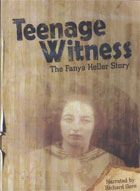
Teenage Witness: The Fanya Heller Story 2010
Distributed by Social Studies School Service, 10200 Jefferson Blvd., Box 802, Culver City, CA 90232; 800-944-5432
Produced by Nikki Silver & Orly Wiseman
Directed by Ed Wiseman
DVD, color, 66 min.
Sr. High - Adult
World War II, Holocaust Studies, Jewish Studies
Date Entered: 03/17/2011
Reviewed by Sheila Intner, Professor Emerita, Graduate School of Library & Information Science, Simmons College GSLIS at Mt. Holyoke, South Hadley, MAIn telling the story of her survival during World War II, which she has also documented in a book titled Love in a World of Sorrow, Fanya Gottesfeld Heller says again and again, “I wanted to live.” Born in Skala, a Ukrainian village of about three and a half thousand souls of whom about a third were Jewish; Fanya was a teenager when the war began. Jews were mostly artisans and small shopkeepers living in the center of town. A good student, Fanya’s father allowed her to remain in school longer than most village girls and she had high hopes of going to Paris to become a doctor.
When the war came to Skala, the Ukrainians, anxious to be rid of their Russian overlords, willingly collaborated with the Nazis, including killing their Jewish neighbors. Jews weren’t herded into ghettos or shipped off to concentration camps. Groups were taken to the forests, forced to dig mass graves and, then, shot, shoved into the pits, and buried, often by Ukrainian neighbors. Fanya attracted the attention of a local policeman named Jan, who secretly hid her and her family in his mother’s attic. After a year in hiding, Fanya’s parents encouraged her to accept a romantic relationship with Jan in order to keep the family alive. When it became to dangerous to hide Jews in town, Jan moved them to the country home of a friend, Izydor Sokolowski, who secreted them, first in his attic, then in his barn, and, later, in a hidden underground space. Jan visited as often as he could without being seen.
When Ukraine was liberated, Fanya’s father disappeared. Fanya heard that Jan had killed him, perhaps, she thought, so her father couldn’t prevent their marriage. The war was over, but Jews were still being killed by Ukrainians. Fanya, her mother and brother fled. Soon after, she met Joseph Heller, a fellow refugee, and married him three weeks later. The survivors lived in Budapest, Vienna, and Munich, and eventually came to the United States.
After her husband’s death, Fanya decided to tell her story—to bear witness to what had happened to her during the Holocaust. She wrote and published a book, Love in a World of Sorrow, and she began speaking to teenagers here in America, particularly inner city teens, whose troubles—hunger, broken families, and abuse—were only too familiar. The teens relate to her experiences. She teaches them about the Holocaust and they find her a willing partner in talking about their troubles, providing courage, by example, not to give up. Through her work, which continues as of the release of the film in 2010, she has re-created herself.
Movingly narrated by Richard Gere, and expertly filmed and edited with interwoven archival clips, photographs, and live action, viewers learn much from this plain-speaking woman who survived unimaginable horrors without losing her spirit or her humanity.
Highly recommended.